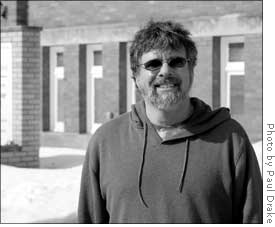
| << Front page | Features | February 23, 2007 |
A Community for Unity
Reverend Hammond Strives to Continue Peace Church’s Inclusive Practices
 |
||
| Rev. Hammond and Peace Community Church: A religious leader who welcomes all people, Hammond continues to encourage his church’s progressive movement. | ||
I’m used to churches that are named after saints, churches whose missions are hidden behind titles that mean nothing to someone with no religious background. My hometown parish, for example: St. Thomas the Apostle Catholic Church. Who is St. Thomas? Why should we care? In the realm of my religious experience, Oberlin’s Peace Community Church is an agreeable anomaly.
On a sleepy Sunday morning, I climbed the stairs of 44 E. Lorain for the 10 a.m. service. I was five minutes late, but just in time to hear Pastor Stephen Hammond announce that the church bells were frozen and that the service would start sans its characteristic campus wake-up call. The 40 or so people inside — a mélange of students, families and older-aged folks — moseyed to the pews.
The congregation was as vibrant as it was cozy. Some parishioners grabbed the colorful seat cushions that were stacked on the ends. One woman in the front settled down next to a large “Congratulations!” balloon, which later became a prop for her to announce her recent retirement. Another woman knitted a small sock. Hammond began with announcements, and I heard my name emitted from his microphone.
“We’ve Kaitlin in the back from the Oberlin Review,” he said in a friendly, croaky voice. “She’s hanging out with us to see what we’re all about.”
With that introduction, I sunk peacefully into my pew as the service got underway.
As well as being a part of the “Baptist Peace Fellowship of North America,” the Peace Community Church is also a “Welcoming and Affirming” church, which means that it formally accepts gay and lesbian members.
Such a pronouncement does not come without ramifications. Shortly after joining the association in 2005, the “fecal matter hit the fan,” as Hammond put it. Until then, the church was affiliated with the American Baptist Churches of Ohio. Because it joined the Association of Welcoming and Affirming Baptists, however, it was kicked out of the Ohio group.
“I got a bit of a sense of what it must be like to be a gay or lesbian person in the church,” Hammond said.
He and his wife Mary, who is the church’s co-pastor, attended meetings concerning this issue in which people critiqued them as if they weren’t present.
“Finally I raised my hand and said, ‘We’re here — if you have any questions you can ask us.’”
Out of the group which represented 20 parishes, only one pastor supported the Peace Community Church. She no longer holds her position.
“We’re just kind of open. We’re willing to let people be who they are,” Hammond said. “There are folk that have trouble with that.”
As a pastor, Hammond fosters participation in a supportive environment.
The parishioners partake in a spiritual open-mic during “Sharing Time.” During the offering, they voice prayers for a variety of recipients: A woman asked the Lord to bless the politician that made her “ooooh, so angry,” while a man wearing a fiery “Red’s Tattooing” jacket prayed for his “left arm, which feels better today.”
Hammond’s Sunday sermon affected both the intellect and the heart. He spoke about dispensationalists (those who believe in a Jewish restoration) and the weakness of their philosophy that some parts of the Bible are only to be applied when necessary.
“Love your friends, but hate your enemies,” was the dispensationalist theory he hit hardest. Assuming that “hate your enemies” translates into “use force when necessary,” he countered that “non-violence really works.”
I attended services the weekend of the Peace Symposium, which included a series of panels, workshops and film screenings focused on a common theme. Junior Sheera Bornstein organized the events to amplify students’ appeal for a more structured means of studying peace and conflict resolution at Oberlin College. The Hammonds were highly visible on campus that weekend.
The Peace Community Church does its part to promote peace on a local level. The church runs a Weekly Peace Vigil that currently meets at noon on Saturday in the DeCafe, but will relocate to Tappan Square in the warmer months. There are monthly peace potlucks, where altruistic parishioners have the opportunity to network and share ideas to promote their causes in the community.
Since the “nasty” events of 2005, as Hammond describes them, regarding the American Baptist Churches of Ohio, the Peace Community Church has joined the Association of the American Baptist Churches of the Rochester-Genoese Region, which Hammond said is more progressive. He used this adjective to put his parish proudly in the context of Oberlin’s religious history.
“Oberlin was the centerpiece of a progressive Christian movement when it was founded,” he said, adding that this mentality persists in the town today. “I just love being connected to that.”
About us
Subscriptions
Advertising